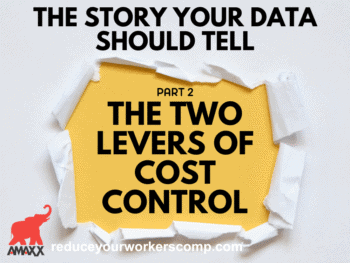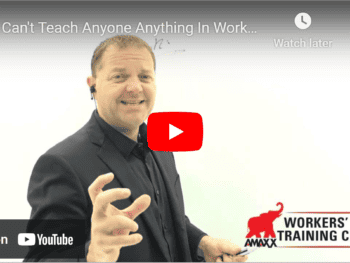Here are 10 tell-tale signs indicating you need to step up your workers’ comp management program and bring it into the new millennium.
1. Your return-to-work ratio is never at 90% of employees returning to work within 1-4 days of a work related incident.
Instead your return-to-work ratio is usually over 60% returning to work from 12 to 120 days after a work related injury. Now is the time to do some trending, and see why so many employees are out of work so long.
2. You never communicate with employees who are out on workers’ comp.
Are employees being kept in a communication loop during convalescence or are they been allowed to lapse in recovery-land where they languish at home and become psychologically dis-employed? Your work comp manager(s) need to be talking to injured employees on a weekly basis.
As soon as the employee is able, those discussions take place at the work site so the employee can reabsorb the look-and-feel of the workplace. This also gives the employee a chance to see work friends and to remember there is something good to return to. If the employee is not able to come to the workplace, bring the workplace to the employee by doing an “outreach visit.”
3. You have avoided or ignored the impact your communication strategy can have on your other work sites. Your work site managers are not held accountable for their employees’ lost time.
Do you conference regularly and insist on sites forwarding trending data to you so you can maintain a composite data site? This is a powerful tool for implementing chargebacks or a worst-to-best list and enforcing the same level of corporate-wide commitment.
4. Your modified duty program has been allowed to lapse. In fact, you haven’t had an employee return to work in a modified duty capacity all year.
Look at your data. When was the last time employees returned to work in modified duty? What was the outcome? Are modified duty job descriptions relevant in that they reflect aspects of actual valuable work. Are they structured to progressively bring the employee back to full-time work? Take a look at the modified duty job descriptions.
Modified duty job descriptions must do two things: (1) represent some aspect of the actual tasks being performed at the workplace, and (2) accommodate the specific disability of the injured employee. Review your modified duty job bank and add a few new tasks to it.
5. You have not had a file review this year, or maybe just one when ramping up your Injury Management program.
Regular periodic file reviews are essential to move open workers’ comp claims toward closure. You need to stay on top of open files, and work regularly with your insurer to ascertain the status of all employees currently out of work and again, work this into the strategy for bringing them back as quickly as possible. An on-site review is best to connect with and evaluate the team that is handling your files. Don’t always choose the easier option which is a telephonic or online review.
6. You allow your insurer to provide loss runs filled with errors.
Review loss runs and other reports you receive from your insurer and make sure the data is up to date, with proper location coding. This includes the proper names and addresses of reported recipients. If they are still sending documentation to a name who no longer works in a certain capacity, you must rein the insurer in because they are out of touch and are costing your money.
7. Your Workers’ Comp Management library publications have copyrights of circa 1980’s.
If this is so, dust the cobwebs off your library and get rid of outdated publications. Subscribe to and receive the latest workers’ comp management and risk management magazines, journals and reference guides.
You should be receiving a wide variety of business publications that keep you abreast of all the latest developments in your field. The laws for workers’ comp change as we speak and they change in every state. Therefore it would behoove you to be on top of trends and legislation and find out what works for your company.
8. You’ve never attended a Workers’ Comp Management or Risk Management conference.
Attending risk management conferences and seminars is another effective way to keep current in the field and to meet your peers and find out what strategies are working for them. Here you can take seminars, establish subscriptions and come home empowered to refresh your Workers’ Comp Management Program. Resource: http://www.reduceyourworkerscomp.com/rims.php
9. You have no idea how much in sales it will take to pay for your work-related incidents.
How badly do work related incidents really hurt your bottom line? If you are really brave, use the sales required to pay for accidents calculator http://www.reduceyourworkerscomp.com/calculator.php to discover how much ($$$$$) injuries and lost time are really costing your company in terms of business sales and profits.
It is a wake up call designed to inspire you to push forward until you have brought your situation under control.
10. You’ve never taken an assessment to discover how the ten areas of workers’ comp management work together to impact your financial well-being.
This is also a good time to take the “WC IQ test” and think about taking the comprehensive assessment to give you a good honest view of where you stand next to WC best practices. (workersxzcompxzkit) http://www.workerscompkit.com/intro
The assessment allows you to examine where your company stands with respect to workers’ comp management best practices. You can obtain an assessment for your divisions, too. Based on your answers the website produces written recommendations you can use as a foundation going forward, i.e., a planning tool.
If your answers to the above questions are anything less than positive, you must:
1. Step up to the plate
2. Take the assessment
3. Answer honestly
4. Make and implement a remedial plan
The assessment is by far the most powerful tool for establishing a good Workers’ Comp Management game plan going forward. You can begin implementation within hours. Use a timetable (a form available when the assessment is complete) to set dates and times to begin implementing your new found remedial strategies, and you will see your costs going down immediately. Good luck!!
Author Robert Elliott, executive vice president, Amaxx Risks Solutions, Inc. has worked successfully for 20 years with many industries to reduce Workers’ Compensation costs, including airlines, health care, manufacturing, printing/publishing, pharmaceuticals, retail, hospitality and manufacturing. He can be contacted at: Robert_Elliott@ReduceYourWorkersComp.com or 860-553-6604.
TO DOWNLOAD OR LISTEN TO FREE FRAUD PREVENTION AUDIO PODCAST click here: http://www.workerscompkit.com/gallagher/mp3 By: Anthony Van Gorp, private investigator with 25 years experience.
Reduce Your Workers Comp: www.ReduceYourWorkersComp.com/
FREE WC IQ Test: http://www.workerscompkit.com/intro/
WC Books: http://www.reduceyourworkerscomp.com/workers-comp-books-manuals.php
TD Calculator: www.ReduceYourWorkersComp.com/transitional-duty-cost-calculator.php
Do not use this information without independent verification. All state laws vary. You should consult with your insurance broker about workers’ comp issues.
©2009 Amaxx Risk Solutions, Inc. All rights reserved under International Copyright Law. If you would like permission to reprint this material, contact Info@WorkersCompKit.com

















